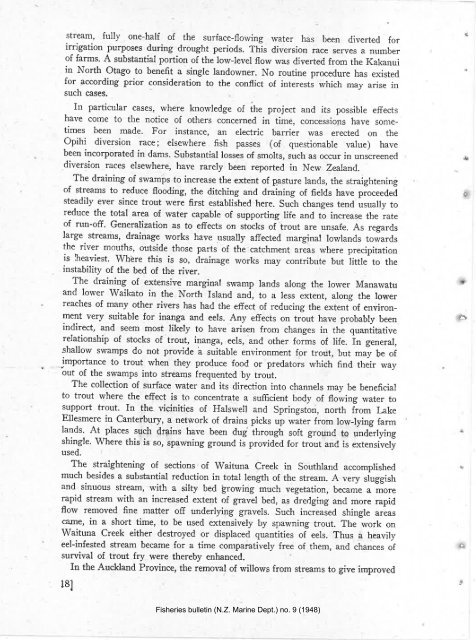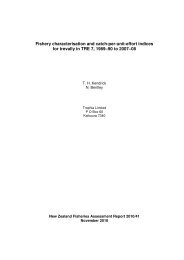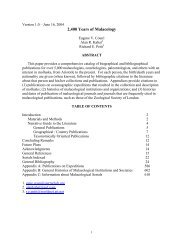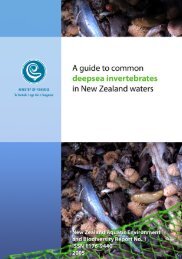N.Z. MARINE DEPARTMENT-FISHERIE,S BULLETIN No. .į
N.Z. MARINE DEPARTMENT-FISHERIE,S BULLETIN No. .į
N.Z. MARINE DEPARTMENT-FISHERIE,S BULLETIN No. .į
Create successful ePaper yourself
Turn your PDF publications into a flip-book with our unique Google optimized e-Paper software.
stream, fully one-half of the surface-flowing water has been diverted for<br />
irrigation purposes during drought periods. This diversion race serves a number<br />
of farms. A substantial portion of the lowJevel flow was diverted from the Kakanui<br />
in <strong>No</strong>rth Otago to benefit a single landowner. <strong>No</strong> routine procedure has existed<br />
for according prior consideration to the conflict of interests which nray arise in<br />
such cases.<br />
In particular cases, where knowledge of ihe project and its possible effects<br />
have come to the notice of others concerned in tirne, concessions have sometimes<br />
been made. For instance, an electric barrier \Mas erected on the<br />
opihi diversio' race; elsewhere fish passes (of questionable value) have<br />
been incorporated in dams. Substantial losses of smolts, such as occur in unscreened<br />
diversion races elsewhere, have rarely been reported in New zealand.<br />
The draining of swamþs to increase the extent of p-asture lancls, the straightening<br />
of streams to reduce flooding, the ditching and dráining of fields have pioceedeã<br />
steadily ever since trout were first established here. Such changes tend usually to<br />
reduce the total area of water capable of supporting life and tã increase the rate<br />
of run-off. Generalization as to effects on stocks of trout are unsafe. As regards<br />
large streams, drainage works have usually affected marginal lowlands towards<br />
the river mouths, outside those parts of the catchment arãas where precipitation<br />
is lheaviest. \4/hère this is so, clrainage works may contribute but little to the<br />
instability of the bed of the river.<br />
The clraining of extensive marginal swamp lands along the lower Manawattr<br />
and lower waikato in the <strong>No</strong>rth Island "nd, to a less .-*terrt, along the lower<br />
reaches of many other rivers has had the effect of reducing the extent of environment<br />
very suitable for inanga and eels. Any effects on trout have probably been<br />
indirect, and seem most likely to have arisen from changes in the quaniitative<br />
relationship of stocks of trout, inanga, eels, and other forms of life. Ín general,<br />
shallow swamps do not provide ä suitable environment for trout, but mù be of<br />
ìmportance to trout when they produce food or predators which find théir way<br />
out of the swamps into streams frequented by trout.<br />
The collection of surface water and its clirection into channels may be beneficial<br />
to trout where the effect is to concentrate a suffi.cient body of flowing water to<br />
support trout. In the vicinities of Halswell and Springston, north from Lake<br />
Ellesmere in canterbury, a network of drains picks up wãter from low-lying farm<br />
lands. At places such drpins have been dug ihrough soft grognd to undãrtying<br />
shingle. Where this is so, spawning ground is providãd for trout and is extensiel|<br />
used.<br />
The straightening of sections of Waituna Creek in Southland accomplished<br />
much besides a substantial reduction in total length of the stream. A very sluggish<br />
and sinuous stream, with a silty bed $rowing much vegetation, became r *or.<br />
rapid stream with an increased extent of gravel bed, as drertging and more rapid<br />
flow removed fine matter off underlying gravels. Such incieased shingle areas<br />
carne, in a short time, to be used extensively by spawning trout. The work on<br />
Waituna Creek either destroyed or displacecl quantities of eels. Thus a heavily<br />
eel-infested stream became for a time comparatively free of them, and chances of<br />
survival of trout fry were thereby enhanced.<br />
In the Auckland Province, the removal of willows from streams to give improved<br />
181<br />
Fisheries bulletin (N.Z. Marine Dept.) no. 9 (1948)







